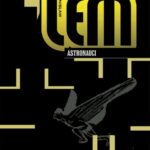Stanislaw Herman Lem is one of the greatest writers of the hard science fiction genre, a futurologist and a thinker. He wrote in Polish. His books have been translated into more than 40 languages.
He belongs to the group of the most eminent Poles.
The Lvivian
Born on 12 September 1921 in Lviv, a city that was a part of Poland before the outbreak of World War II. He was the only child of Sabina and Samuel Lehm. It was only during his studies, when the Germans entered Lviv, that he learned about his Jewish roots.
A carefree childhood
Lem spent his childhood in a carefree atmosphere, his parents were wealthy people. He could experiment and construct inventions. His hobbies and interests were not limited.
He described his childhood and adolescence in his autobiographical, most personal book “High Castle”.
“The child I was interests me and disturbs me at the same time. Though I did not murder anyone except dolls and gramophones, it should be taken into account that I was physically weak and feared reprisals from adults. My father never smacked me, my mother occasionally did this, that’s all, but there were many other, less direct means and ways, from verbal reprimands to legumina obstruction. If four-year-old children were as strong as their parents, our world would look different.
(“High Castle”)
Education
He graduated from the Karol Szajnocha Gimnazjum in Lviv in September 1939. If not for the outbreak of the war – Germans on September 1, 1939 attacked western and northern Poland and Soviets began occupation of Lviv in autumn 1939 – Lem would have probably studied at the Technical University, which was his dream. He was not accepted due to the wealth and education of his family. Thanks to the patronage of his father, a well-known laryngologist, in 1940 he started studying medicine at the Medical Institute. When he finished the first year of his studies, the German army entered Lviv and Lem could not study. After the war he continued medical studies in Cracow.
The Pressure of History
“In fact, it was only to Nazi legislation that I owe the realization that Jewish blood runs in my veins. However, we managed to avoid imprisonment in the ghetto – thanks to false documents I managed to survive that time together with my parents”.
(“High Castle”)
At that time, as he noted in his autobiography, he appreciated the role and importance of chance. In a world of uncertainty and danger, life and death were to be determined by, for example, the choice of which street to walk to work on.
In 1944, Soviet troops once again occupied Lviv. The tension grew, the reality for Stanislaw and his parents became more and more complicated.
“My parents, especially my father, believed so strongly in the Allies saving Lviv for Poland that we stayed there far too long. We only left when we were told: either you go to Poland or take Soviet passports”, he recalled. They left, having lost all their possessions and taking only the essentials. Lem never came back to his beloved Lviv.
In 1946 the Lehm family moved to Cracow, to a modest apartment. Samuel Lehm, despite his old age and heart disease, took up a job in a hospital. Stanisław enrolled in medicine at the Jagiellonian University. However, he did not take the final exams and did not become a doctor.
“Man from Mars”, “Hospital of the Transfiguration”
He began to write for various titles, trying to earn money. In 1946, his first literary work of science fiction, “The Man from Mars,” was published in the magazine “New World of Adventure.” Lem himself was not satisfied with this work.
His first outstanding work – “Hospital of the Transfiguration” – was written in 1948.
At that time, power in Poland was exercised by a communist government dependent on Moscow, as determined by the president of the United States, the prime minister of Great Britain, and the leader of the Soviet Union. Lem’s book was considered dangerous to the communist ideology and its printing was stopped.
Welcomes and partings
In the 1950s. Lem met Barbara Leśniak, a medical student. They got married in the Church of Saints Peter and Paul in Krakow in February 1954. It was also then that an extremely important friendship with Jan Józef Szczepański, a writer and reporter, was born.
Fame and recognition
In 1961, the novel “Astronauts” was published, and a few years later another one – “Magellanic Cloud”. Lem did not like both works, but paradoxically, they gave him fame and recognition.
Continuous searching and discovering
The acquaintance with doctor Mieczysław Choynowski resulted in the beginning of his cooperation with a magazine “Life of Science”. Lem found a job in the Science Studies Seminar. As a result, he gained access to the latest world literature and could start learning English.
At that time Poles could not travel freely around the world and even in Europe. In fact, as it was pre-Internet era, access to books from overseas was extremely rare, even impossible.
Lem was focused on constant searching and discovering. He was constantly learning, also as an adult.
Writing achievements
The most fruitful period began in 1959, when the novels “Eden” and “Investigation” were published, as well as the short stories “Invasion from Aldebaran”. Two years later Lem published other books that were considered masterpieces: “Diary Found in a Bathtub”, “Solaris” and “Return from the Stars”. In 1964, “Tales of the Robots”, “Invincible” and “Summa Technologiae” reached the readers’ hands. In 1965, “Cyberiad” and “The Hunt” were published, followed a year later by the autobiographical “High Castle”. In 1968 “Voice of the Lord” was published – an outstanding, one of Lem’s most seasoned works. One should also not forget “The Futurological Congress” from 1971.
In 1987 Lem’s last novel “Fiasco” was published, a pessimistic story of a pioneering man’s flight to one of the stars.
Reception of the work
Lem’s books have been interpreted and read in many different ways. Some critics trivialized his work. At the same time his novels were read by scientists, Russian astronauts and ordinary readers looking for deep and even metaphysical content. Many of his works have been made into films.
Cultural analysis
In the 1990s Lem focused on analyzing culture, as well as making futurological predictions.
“I am irritated by evil and stupidity. Evil arises from stupidity, and stupidity feeds on evil. Television is full of violence and it makes the infliction of evil more ordinary. Technology has increased the anonymity of crime. The Internet makes it easier to do unto others what is unkind to them. I recently read about a young man who attempted, almost successfully, to control the main computer of a US aircraft carrier from his hotel room. If I had written this thirty years ago, everyone would have said I was crazy. Today such a paradox is within the realm of possibility. The entire history of mankind is one blink of a second on a geological clock. We are living at a pace of incredible acceleration. We are in the situation of a man who has jumped off the roof of a fifty-story skyscraper and is currently at the height of the thirtieth floor. Someone leans out and asks: “How’s it going?” and the faller says: “So far so good.” We don’t realize the tremendous speed that has taken hold of us. With increasingly powerful technologies, we have less and less control over the direction they take.” (“So Said Lem”)
What was Lem like?
He was a sociable, cheerful and hospitable person. He liked jokes, although not necessarily about himself. He resented criticism of his work. He could be irritated, but he was also surprisingly open. In the last years of his life he rarely left home, although he received numerous invitations. Despite serious circulatory problems, he never lost his passion for exploring and curiosity about the world. He had a weakness for sweets, especially challah.
He was friends with Jan Józef Szczepański, godfather to his son Tomasz, and Władysław Bartoszewski. He corresponded with the writer and playwright Sławomir Mrożek, and once gave a lecture at the Cracow curia at the invitation of Cardinal Karol Wojtyła, later Pope John Paul II, whom he knew personally.
A typewriter
He wrote all his works on a typewriter and never learned to use a computer. He started working every day at 4 am and spent a lot of time reading and writing letters, receiving them from all over the world. As an allergic, he spent a lot of time in the mountains and wrote most of his texts during his stay at the Asturian Writers’ House in Zakopane.
Over 40 and 30,000,000
The number of languages into which his books were translated exceeded forty, and the total circulation of his books definitely exceeded thirty million. Lem’s most famous book is “Solaris.” He created in it the most original vision of the alien in the entire history of science-fiction literature.
Stanisław Lem died on March 27, 2006 in a hospital in Cracow.
Subjective reading list
I suggest you start reading Lem’s books from:
List 1.
- Solaris
- Bajki robotów
- Pamiętnik znaleziony w wannie
- Opowieści o Pilocie Pirxie
- Głos Pana
List 2.
- Bajki robotów
- Solaris
- Summa technologiae
- Głos Pana
- Kongres futurologiczny













